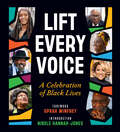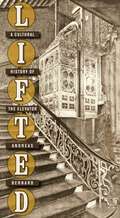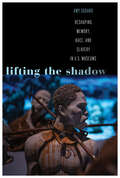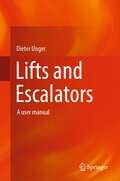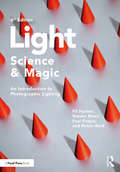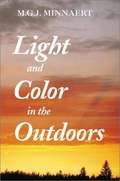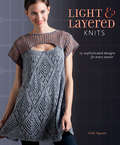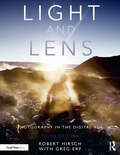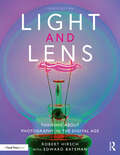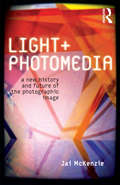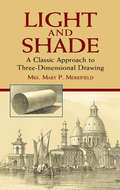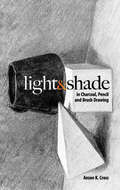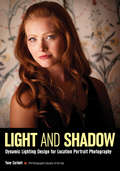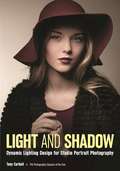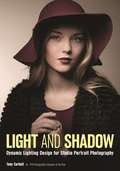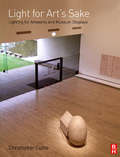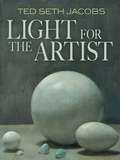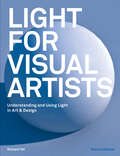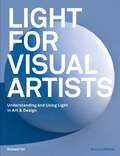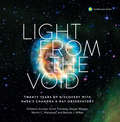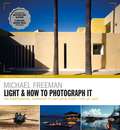- Table View
- List View
Lift Every Voice: A Celebration of Black Lives
by Oprah Winfrey Nikole Hannah-Jones&“When we lift every voice, we forge a deep and enduring connection to the past—and carve a tunnel of hope to a brighter future for us all.&” -Oprah Winfrey &“This book, above all else, is a reminder of where we have been and the debt we owe to those who came before. These Americans have not passed the torch, but are clasping it with us, urging us to continue the work alongside them,&”-Nikole Hannah-Jones More than 50 elders share their remarkable experiences of being Black in America in a collection of powerful photographs and interviews For so long, too many stories that reveal what it means and feels like to be Black in America have been overlooked outside Black communities. After these long years of racial reckonings and nascent awakenings, Lift Every Voice presents interviews with the oldest generation of Black Americans about their lives, their experiences, and the wisdom that can carry all of us to a better future. The 54 fascinating individuals—civil rights activists, hometown heroes, celebrities, and many others—include: • Andre de Shields, an actor, director, and choreographer who discusses the essential values and lessons his parents taught him • Clarice Freeman, an educator and community leader in Houston, Texas who speaks about how to live a long and fulfilling life • Fred Gray, a civil rights lawyer who represented Rosa Parks and Claudette Colvin, also featured in the book, against disorderly conduct charges for their refusal to give up their bus seats to white passengers • Patti LaBelle a singer/songwriter who shares her thoughts on aging and her career as an internationally celebrated powerhouse singer • Faye Wattleton, a reproductive rights activist and the first African American and youngest president of Planned Parenthood who recounts her experience as a nurse and midwife in the 1960s The insightful interviews were conducted by a brilliant team, many of whom are rising Black journalists from historically Black colleges and universities, and the portraits were shot by a talented group of next generation Black photographers. Lift Every Voice is named after the James Weldon Johnson poem and hymn "Lift Every Voice and Sing," which is often referred to as the "Black national anthem." Lift Every Voice is both a testament to the strength of the elders&’ stories and a triumphant beginning for a new generation of Black journalists and photographers.
Lifted: A Cultural History of the Elevator
by Andreas BernardBefore skyscrapers forever transformed the landscape of the modern metropolis, the conveyance that made them possible had to be created. Invented in New York in the 1850s, the elevator became an urban fact of life on both sides of the Atlantic by the early twentieth century. While it may at first glance seem a modest innovation, it had wide-ranging effects, from fundamentally restructuring building design to reinforcing social class hierarchies by moving luxury apartments to upper levels, previously the domain of the lower classes. The cramped elevator cabin itself served as a reflection of life in modern growing cities, as a space of simultaneous intimacy and anonymity, constantly in motion. In this elegant and fascinating book, Andreas Bernard explores how the appearance of this new element changed notions of verticality and urban space. Transforming such landmarks as the Waldorf-Astoria and Ritz Tower in New York, he traces how the elevator quickly took hold in large American cities while gaining much slower acceptance in European cities like Paris and Berlin. Combining technological and architectural history with the literary and cinematic, Bernard opens up new ways of looking at the elevator--as a secular confessional when stalled between floors or as a recurring space in which couples fall in love. Rising upwards through modernity, Lifted takes the reader on a compelling ride through the history of the elevator.
Lifting the Shadow: Reshaping Memory, Race, and Slavery in U.S. Museums (Genocide, Political Violence, Human Rights)
by Amy SodaroLifting the Shadow: Reshaping Memory, Race, and Slavery in U.S. Museums examines a small but significant wave of new U.S. memorial museums that focus on slavery and its ongoing violent legacies, including the Smithsonian National Museum of African American History and Culture, Montgomery’s Legacy Museum: From Enslavement to Mass Incarceration, and Greenwood Rising, which commemorates the 1921 Tulsa Race Massacre. These museums are challenging historical narratives of slavery and race by placing racial oppression at the center of American history and linking historical slavery to contemporary racial injustice, but they have opened in a period marked by growing racial tension, white nationalism, and political division. Sodaro examines how the violence of U.S. slavery and its lasting legacies is negotiated in these museums, as well as their potential to contribute to the development of a more critical historical memory of race in the U.S. at this particularly volatile sociopolitical moment.
Lifts and Escalators: A user manual
by Dieter UngerThis book offers everyone who plans, builds or operates lifts and escalators a comprehensive overview of the important topics: starting with the standards and technical rules through to the history of technology. Planning, operation, maintenance and documentation of lifts and escalators are described. Numerous meaningful color illustrations complement the text. The book serves as a reference work for operators of lifts and escalators. The many examples, tips and advice from practice make it a helpful companion in daily work.
Light — Science & Magic: An Introduction to Photographic Lighting
by Fil Hunter Steven Biver Paul Fuqua Robin ReidPhotographic lighting is a topic that will never go out of style, no matter how sophisticated cameras and other technology get. Even with the most high-tech gear, photographers still need to put a lot of thought and vision into lighting their photographs in order to get great results. Mastering this key skill has the power to dramatically and quickly improve your photographs as well as your efficiency. Light—Science & Magic provides you with a comprehensive theory of the nature and principles of light, with examples and instructions for practical application. Featuring photographs, diagrams, and step-by-step instructions, this book speaks to photographers of varying levels. It provides invaluable information on how to light the most difficult subjects, such as surfaces, metal, glass, liquids, extremes (black-on-black and white-on-white), and portraits. This new edition includes: • Expanded chapters on portraiture and lighting equipment • Chapters on necessary equipment when working on location versus in the studio • An updated appendix of reliable photo gear sources • Over 100 new photographs and informational sidebars • Updated information about advances in flash equipment, LED panels, and fluorescent lights Lighting styles will evolve, but the science of light will always remain the same. Once photographers understand the basic physics of lighting (without having to become physicists), they can apply that knowledge to a broad range of photographic styles.
Light and Color in the Outdoors
by L. Seymour M. G. J. MinnaertLight and Color in the Outdoors by the Dutch astronomer Marcel Minnaert (1893-1970) is a classic among books on the physics of nature. In its pages Minnaert will show you where to find the extraordinary array of light and color phenomena that may be seen in the open air; in every case he discusses their physical explanations and connections to other related phenomena. His book is intended for everybody who loves the outdoors: many of the treasures of nature presented here may even be observed in a crowded city.
Light and Layered Knits: 19 Sophisticated Designs for Every Season
by Vicki SquareCreate fluid, fashionable garments you'll wear over and over again!Best-selling author Vicki Square returns, this time creating beautiful garments made from comfortable fibers and light yarns. These are more than simply projects to make-they are truly knits to live in.The 23 patterns of Light & Layered Knits work in all climates, can be layered and removed at will, and are equally at home in a casual or workplace setting. Working with lightweight yarns in fibers such as silk, linen, cotton, and bamboo, Vicki creates pieces that will appeal to knitters of all ages.These versatile wardrobe staples-shells, fluid tops, draped tunics, light cardigans, wrap sweaters, and more-reflect the way that women dress today. What's more, most of them are conveniently sized for up to a "46" to "48" bust circumference.
Light and Lens
by Robert HirschLight & Lens: Photography in the Digital Age is a groundbreaking introductory book that clearly and concisely provides the instruction and building blocks necessary to create thought-provoking digitally based photographs. It is an adventurous idea book that features numerous classroom-tested assignments and exercises from leading photographic educators to encourage you to critically explore and make images from the photographers' eye, an aesthetic point of view. Acquire a basic foundation for digital photography. Light and Lens covers the fundamental concepts of image-making; how to use today's digital technology to create compelling images; and how to output and preserve images in the digital world.Explore the history, theory and methods of digital image-making. Light and Lens translates the enduring aesthetics of art photography into the digital realm. You'll view, capture and think about images from a new perspective.Increase your ability to analyze, discuss and write about your own work and the images of others.Learn with exercises and assignments by leading digital educators. Innovative techniques will train your eye to make the strongest visual statement.Solve visual problems and overcome image challenges. Whether you use a digital SLR or a point-and-shoot camera, you'll get new strategies to master composition, design and light. View the full range of the digital terrain with stunning images and commentary by over 190 international artists.Robert Hirsch is a renowned photographer, educator, historian and writer. His book credits include Photographic Possibilities: The Expressive Use of Ideas, Materials and Processes; Exploring Color Photography: From the Darkroom to the Digital Studio; and Seizing the Light: A History of Photography. He has had many one-person shows and curated numerous exhibitions. Hirsch has also conducted many workshops and interviewed eminent photographers of our time. The former executive director of CEPA Gallery, he is now the director of Light Research in Buffalo, New York, and on the Visual Studies faculty of University of Buffalo/The State University of New York.
Light and Lens: Photography in the Digital Age
by Robert HirschThe new edition of this pioneering book allows students to acquire an essential foundation for digital photography. Fully updated, it clearly and concisely covers the fundamental concepts of imagemaking, how to use digital technology to create compelling images, and how to output and preserve images in the digital world. Exploring history, methods, and theory, this text offers classroom-tested assignments and exercises from leading photographic educators, approaches for analyzing, discussing, and writing about photographs, and tools to critically explore and make images with increased visual literacy. New to this edition: • New larger page format • Revised and renewed to reflect technological advances • Expanded coverage of smartphone/mobile photography • Extended coverage of the careers section • More than 100 new images
Light and Lens: Thinking About Photography in the Digital Age
by Robert HirschThe latest edition of this pioneering book allows students to acquire an essential foundation for digital photography. Fully updated, it clearly and concisely covers the fundamental concepts of imagemaking, how to use digital technology to create compelling images, and how to output and preserve images in the digital world. Exploring history, methods, and theory, this text offers classroom-tested assignments and exercises from leading photographic educators, approaches for analyzing, discussing, and writing about photographs, and tools to critically explore and make images with increased visual literacy. New to this fourth edition: Completely updated and renewed to reflect social trends and technological advances Highly reconstructed Chapter 3: Image Capture: Cameras, Lenses, and Scanners Revamped Chapter 4: Exposure: Capturing the Light Entirely new Chapter 8: Digital Studio: The Virtual and the Material Worlds Expanded smartphone photography coverage Featuring nearly 300 international artists and over 360 innovative images and illustrations New engaging assignments Ideal for undergraduate students of digital photography and hobbyist photographers.
Light and Photomedia: A New History and Future of the Photographic Image (International Library Of Visual Culture Ser.)
by Jai McKenzieLight and Photomedia proposes that, regardless of technological change, the history and future of photomedia is essentially connected to light. It is a fundamental property of photomedia, binding with space and time to form and inform new, explicitly light-based structures and experiences. Jai McKenzie identifies light-space-time structures throughout the history of photomedia, from the early image machines through analogue and digital image machines to the present day. She proposes that they will continue to develop in the future and takes us to future image machines of the year 2039. With the use of the theories of Paul Virilio, Jean Baudrillard and Vilem Flusser, featuring artists including Henri Cartier-Bresson, Nam June Paik, Yves Klein, Eadweard Muybridge, Martha Rosler, Cindy Sherman and Michael Snow, as well as their photographic images, Light and Photomedia places the reader in a new history and future which, although mostly overlooked by the canon of photomedia theory, is an essential line of enquiry for contemporary thinking and dialogue in photography.
Light and Shade: A Classic Approach to Three-Dimensional Drawing
by Mary Merrifield"Form," writes the author, "is developed by means of light and shade; without these every object would appear flat." Originally published in the mid-nineteenth century, this classic approach to three-dimensional drawing was the first book to provide art students with instructions for correctly illustrating perspective outlines of various objects. An art historian noted for her authoritative reference works, Merrifield clearly demonstrates the principles of light and shade by revealing the effects of common daylight, sunshine, and candle or artificial light on geometrical solids. Her simple explanations are accompanied by illustrations of cubes, prisms, pyramids, cylinders, spheres, ovals, and cones.As useful and practical today as it was when first published well over a century ago, Light and Shade provides beginning and advanced art students with valuable insights into effective drawing and sketching.
Light and Shade in Charcoal, Pencil and Brush Drawing (Dover Art Instruction)
by Anson K. CrossAn instructional book for intermediate and advanced students, this volume is also a valuable tool for teachers looking to master the principles of light and shade. One of the most in-depth treatments available, it offers a wealth of details on mediums and techniques, including natural and artificial light, gradations, and more.Author Anson K. Cross begins with studies of chiaro-oscura, or light and shade, and examples of values and their tests. He discusses the aims of students and artists and offers some general advice on technique and method before exploring the specifics of charcoal, pencil, and brush drawing. Sixty-five black-and-white illustrations, many of them drawn by students, appear throughout the book.
Light And Shadow: Dynamic Lighting Design For Location Portrait Photography
by Tony CorbellNatural light portraiture is hugely popular. The light source is free, malleable, and available anywhere. Mastering its use requires a specific skill set, however. Fortunately, Tony Corbell is up to the task of showing readers how to harness its full power. He sets a foundation for mastering this powerful source, beginning with a discussion on how to set camera controls to ensure the right amount of light is allowed to strike the image sensor to create the portrait and how to read a histogram to ensure that a subject-appropriate (versus so-called "correct”) exposure results. Next, he moves on to discuss light quantity and quality and how each can be modified and manipulated to produce dimensional, lifelike portraits. Readers will learn techniques for using hard/soft light, working with window light, ensuring a proper white balance (so that colors in the scene are true-to-life in the final image), and adding or subtracting light to achieve the desired effect. Corbell’s images and instructions show readers how to produce the flattering, highly salable portraits they’re after--indoors and out.
Light and Shadow
by Tony CorbellStudio lighting offers portrait photographers unlimited creative control. Mastering its use requires a specific skill set, however. Fortunately, portrait photography legend Tony Corbell is up to the task of showing readers how to harness its full power. He sets a foundation for mastering the use of strobes and continuous lighting sources (LEDs, tungsten lights, and fluorescent sources), creating effective lighting setups (with the aid of detailed, yet simple-to-understand diagrams), metering and adjusting the light, correcting color imbalances, softening harsh shadows, and more. He also introduces readers to the proper use of standard photographic modifiers -- softboxes, umbrellas, octoboxes, beauty dishes, and other tools -- so that they can sculpt their every portrait subject with incredibly flattering light. This book is filled with over 150 inspiring and instructive images from a true master of the craft. In these pages, readers will learn step-by-step instructions for mastering the many critical concepts one must understand to gain mastery over light. Armed with simple strategies for studio lighting, readers can repeatedly re-create Corbell’s award-winning portrait lighting looks with their own clients.
Light and Shadow
by Tony CorbellStudio lighting offers portrait photographers unlimited creative control. Mastering its use requires a specific skill set, however. Fortunately, portrait photography legend Tony Corbell is up to the task of showing readers how to harness its full power. He sets a foundation for mastering the use of strobes and continuous lighting sources (LEDs, tungsten lights, and fluorescent sources), creating effective lighting setups (with the aid of detailed, yet simple-to-understand diagrams), metering and adjusting the light, correcting color imbalances, softening harsh shadows, and more. He also introduces readers to the proper use of standard photographic modifiers -- softboxes, umbrellas, octoboxes, beauty dishes, and other tools -- so that they can sculpt their every portrait subject with incredibly flattering light. This book is filled with over 150 inspiring and instructive images from a true master of the craft. In these pages, readers will learn step-by-step instructions for mastering the many critical concepts one must understand to gain mastery over light. Armed with simple strategies for studio lighting, readers can repeatedly re-create Corbell’s award-winning portrait lighting looks with their own clients.
Light for a Cold Land: Lawren Harris's Life and Work
by Peter LariseyLawren Stewart Harris’ artistic career began in the first decade of our century. Well known for the nationalist-inspired landscapes that he painted between 1908 and 1932, Harris turned resolutely in 1934 to the painting of abstractions. He continued to create works that reflected his own modernist and mystical developments until the end of his life. Canadians praise Harris’ landscapes and admire him as a planner of innovative and heroic-sounding sketching trips into the North. He is also recognized as the chief organizer of the Group of Seven. A long list of younger artists he considered creative greatly benefited from Harris’ encouragement and often generous, practical help; many of them have been interviewed for this book. In the lives of some Canadians harris still functions as a gurulike guide – a role he was quite content to take on during his own lifetime – because of the spiritual content of his art and aesthetic writings and the example of his optimistic, vigorous and apparently untroubled life. But Harris’ was not an untroubled life, and Light for a Cold Land examines his personal crises and difficulties, some of which caused important changes in his art. The book also uncovers the painting styles, artistic tensions and cultural dynamics of the German milieu in which Harris received his only formal art education. His student years in Berlin profoundly influenced not only his art but also his artistic politics and his philosophy. It is ironic that in the art of this most articulate of Canadian nationalist painters, there are extensive German influences. Light for a Cold Land is the first art-historical study of Lawren Harris that attempts to explore his life and all aspects of his career. It is based on extensive work in archives, libraries, public art galleries and private collections in Canada, as well as research in Germany and interviews with members of Harris’ family and many of his friends, acquaintances, colleagues and critics.
Light for Art's Sake
by Christopher CuttleConservation scientists in museums and galleries have a clear understanding of the damage that light can inflict on an object, but what of the designers that create exhibitions to display these precious items? Light for Arts Sake provides a basis for a level of professional expertise for lighting practice in museums. Rather than portraying conservation and display as having diametrically opposed objectives, the central concept is that the interaction of light and art media is the source for both the visual experience and the degradation of the artwork. Optimal solutions derive from understanding and controlling the interaction process, and the need is for the level of understanding among lighting professionals to be brought closer to that found among conservation scientists.
Light for the Artist (Dover Art Instruction)
by Ted Seth JacobsIntermediate and advanced art students receive a broad vocabulary of effects with this in-depth study of light. Topics include basics, use of light to define form and space, field effects, colored light, and many other subjects. Diagrams and paintings illustrate applications of principles to figure, still life, and landscape paintings.
Light for Visual Artists: Understanding And Using Light In Art And Design
by Richard YotLight is as important as colour in creating the right effect, whether on a palette or on a computer. Whether you’re an animator, painter, photographer or illustrator, you need to know how to harness light in your work to create the right effect. Light for Visual Artists is the first and only book that explores the way light can be used to create realistic and fantastical effects in a wide range of media. Illustrator Richard Yot, known for his work in film as a lighting artist and stylised 3D illustrations, takes you through the fundamental properties of natural and artificial light, shadows, the interaction of light on different types of surfaces, reflections, as well as transparency, translucency and the effects of light on colour. Richard also explores how to observe the effects of light to create realistic images, and the creative use of light in composition and design for creating moods or setting a scene. This second edition has been updated with revised photos and artwork, as well as 15 practical exercises and new online video material.Packed with diagrams and illustrations, as well as computer game and film stills, Light for Visual Artists is an invaluable resource for animators, digital illustrators, painters, photographers and artists working in any medium.
Light for Visual Artists: Understanding & Using Light in Art & Design
by Richard YotLight is as important as colour in creating the right effect, whether on a palette or on a computer. Whether you’re an animator, painter, photographer or illustrator, you need to know how to harness light in your work to create the right effect. Light for Visual Artists is the first and only book that explores the way light can be used to create realistic and fantastical effects in a wide range of media. Illustrator Richard Yot, known for his work in film as a lighting artist and stylised 3D illustrations, takes you through the fundamental properties of natural and artificial light, shadows, the interaction of light on different types of surfaces, reflections, as well as transparency, translucency and the effects of light on colour. Richard also explores how to observe the effects of light to create realistic images, and the creative use of light in composition and design for creating moods or setting a scene. This second edition has been updated with revised photos and artwork, as well as 15 practical exercises and new online video material.Packed with diagrams and illustrations, as well as computer game and film stills, Light for Visual Artists is an invaluable resource for animators, digital illustrators, painters, photographers and artists working in any medium.
Light for Visual Artists Second Edition: Understanding, Using Light in Art & Design
by Richard YotThis introduction to light for students and visual artists explores the way light can be used to create realistic and fantastical effects in a wide range of media. Divided into three parts, the clearly written text explains: the fundamental properties of natural and artificial light; how to create realistic images by observing people and the environment; the creative use of light in composition and design. Updated with revised photos and artwork, as well as 15 practical exercises and new online video material, this second edition is an indispensable resource for animators, digital illustrators, painters, photographers and artists working in any medium.
Light for Visual Artists Second Edition: Understanding, Using Light in Art & Design
by Richard YotThis introduction to light for students and visual artists explores the way light can be used to create realistic and fantastical effects in a wide range of media. Divided into three parts, the clearly written text explains: the fundamental properties of natural and artificial light; how to create realistic images by observing people and the environment; the creative use of light in composition and design. Updated with revised photos and artwork, as well as 15 practical exercises and new online video material, this second edition is an indispensable resource for animators, digital illustrators, painters, photographers and artists working in any medium.
Light from the Void: Twenty Years of Discovery with NASA's Chandra X-ray Observatory
by Kimberly K. Arcand Megan Watzke Grant Tremblay Martin C. Weisskoph Belinda J. WilkesA lavish coffee-table book featuring spectacular images from the Chandra X-Ray Observatory, the most powerful X-Ray telescope ever builtTake a journey through the cosmos with Light from the Void, a stunning collection of photographs from the Chandra X-Ray Observatory's two decades of operation. The book showcases rarely-seen celestial phenomena such as black holes, planetary nebulae, galaxy clusters, gravitational waves, stellar birth and death, and more. Accompanying these images of incredible natural phenomena are captions explaining how they occur. The images start close to home and move outward: beginning with images of the Chandra launch, then moving into the solar system, through the nearby universe, and finally to the most distant galaxies Chandra has observed, the book brings readers on a far-out visual voyage.
Light & How to Photograph It: The Professional Approach To Capturing Every Type Of Light
by Michael FreemanFor professional photographers, chasing the light, waiting for it, sometimes helping it, and finally capturing it is a constant preoccupation and for some, an obsession. Drawing on four decades of working with light, Michael Freeman takes a simple but practical approach to interpreting, reacting to, and capturing photography's most valuable commodity.Practical advice is organised into three straightforward sections: Waiting, Chasing, and Helping. Begin by mastering the art of patience, and recognise the immense value of anticipating and planning for gorgeous light that's just over the horizon. Then learn the techniques to meet otherwise transient and fleeting lighting conditions halfway, with quick thinking and fast reactions. Finally, make the most of the tools at your disposal to enhance and manipulate light as you find it, covering everything from in-the-field shooting choices to technical transformations in post-production. This is the method of a working professional - to interpret, approach, and master whatever lighting situation is thrown at you and always get the shot, no matter what.
